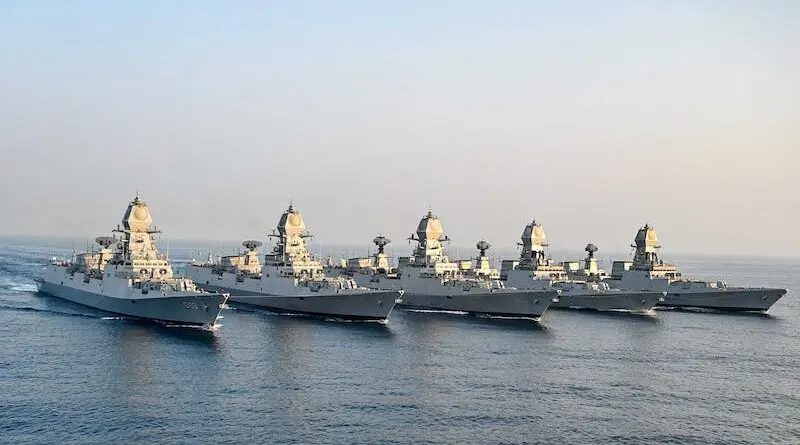TROPEX-2025: Strengthening India’s Maritime Resolve In The Indo-Pacific – Analysis
By Ashu Mann
In the face of evolving maritime challenges and the shifting dynamics of global geopolitics, India has once again demonstrated its unwavering commitment to securing the Indo-Pacific region through the successful execution of the Theatre Level Operational Readiness Exercise (TROPEX) 2025.
This biennial exercise, conducted by the Indian Navy with active participation from the Indian Army, Air Force, and Coast Guard, is a testament to India’s robust maritime capabilities, strategic foresight, and dedication to regional stability.
A Comprehensive Display of Maritime Strength
TROPEX-2025, spanning from January to March 2025, unfolded across the vast expanse of the Indian Ocean Region (IOR). The exercise encompassed harbour and sea phases, integrating various facets of combat operations, cyber and electronic warfare, live weapon firings, and amphibious exercises (AMPHEX). The scale of TROPEX-2025 was unprecedented, with approximately 65 Indian Naval ships, nine submarines, and over 80 aircraft participating in complex maritime operational scenarios. This extensive mobilisation aimed to validate and refine the Navy’s Concept of Operations, emphasising forward-deployed sustenance and interoperability with other services.
A highlight of the exercise was the deployment of India’s indigenous aircraft carrier, INS Vikrant, symbolising the nation’s strides towards self-reliance in defence manufacturing. Accompanying INS Vikrant were state-of-the-art Visakhapatnam and Kolkata Class destroyers, Kalvari Class submarines, and an array of advanced aircraft, including the MiG-29K fighters, P-8I maritime patrol aircraft, HALE Sea Guardian drones, and MH-60R helicopters. The integration of these platforms showcased India’s capability to orchestrate coordinated and precise maritime operations, reinforcing its position as a formidable naval power in the Indo-Pacific.
Jointmanship and Interoperability: The Cornerstones of TROPEX-2025
The essence of TROPEX-2025 lies in its emphasis on jointmanship and seamless interoperability among the Indian Armed Forces. The exercise witnessed the convergence of assets from the Indian Army, Air Force, and Coast Guard, operating in unison to simulate real-world combat scenarios. The Indian Air Force contributed with Sukhoi-30 and Jaguar fighter aircraft, C-130 transport planes, flight refuellers, and AWACS aircraft, enhancing the exercise’s aerial dimension. The Indian Army’s involvement included an infantry brigade comprising over 600 troops, participating in amphibious landings and establishing beachheads, demonstrating the capability to effectively project power from sea to land.
A significant event during TROPEX-2025 was the embarkation of senior military leadership, including the Vice Chiefs of the Army, Navy, and Air Force, aboard frontline naval ships such as INS Vikrant and INS Jalashwa. Their presence underscored the high level of coordination and the importance of integrated operations. These leaders witnessed dynamic operations, including missile firings, anti-submarine drills, and extensive flying operations by MiG-29K fighters and various helicopters, both day and night. Such high-level participation not only boosts the forces’ morale but also signifies a unified strategic vision aimed at safeguarding India’s maritime interests.
Strategic Significance in the Indo-Pacific Context
The Indo-Pacific region, a pivotal conduit for global trade and energy flows, has increasingly become a theatre of strategic competition. Emerging challenges, including assertive maritime claims and the militarisation of critical sea lanes, necessitate a proactive and prepared stance. TROPEX-2025 is a clear signal of India’s resolve to maintain peace, stability, and the rule of law in these waters.
The exercise’s expansive scope, covering the Arabian Sea, the Bay of Bengal, and the broader Indian Ocean, reflects India’s capability to monitor and secure critical maritime zones. By rigorously testing combat readiness through simulated warfare scenarios, anti-submarine operations, and amphibious landings, TROPEX-2025 ensures the Indian Navy remains poised to counter conventional, asymmetric, and hybrid threats. This readiness is crucial in deterring potential adversaries and reassuring regional partners of India’s commitment to collective security.
Countering China’s Maritime Expansion: The Role of TROPEX in Power Projection
China’s People’s Liberation Army Navy (PLAN) has aggressively expanded its presence in the Indian Ocean, frequently deploying warships and intelligence-gathering vessels near territorial waters. The establishment of a PLA Navy base in Djibouti, strategic military agreements with Sri Lanka and Pakistan, and its expanding naval footprint in the Bay of Bengal through economic coercion tactics have raised serious security concerns for India.
TROPEX 2025 sends a powerful message that India is not a passive bystander but a formidable force willing to challenge such incursions. The inclusion of offensive naval tactics, area denial strategies, and multi-theatre force deployment showcases India’s preparedness to intercept, neutralise, and eliminate threats in its maritime domain.Moreover, by deepening naval cooperation with the Quad, ASEAN partners, and regional allies like France (which has strategic bases in the Indian Ocean), India is ensuring that the Indo-Pacific remains free from unilateral dominance.
A Final Warning to Hostile Powers
As the exercise concludes, one thing is clear: India will not tolerate maritime coercion, territorial incursions, or hegemonic ambitions that threaten its national security and regional stability. TROPEX 2025 cements India’s position as the leading maritime force in the Indo-Pacific, ready to counter threats, protect vital sea lanes, and uphold the principles of freedom of navigation.
For adversaries who seek to encroach upon India’s maritime domain, TROPEX 2025 is a stark reminder that the Indian Navy is equipped, prepared, and determined to enforce its sovereign rights and strategic interests. Whether it is PLA naval vessels prowling in the Indian Ocean, Chinese spy ships attempting to gather intelligence near India’s naval bases, or coercive debt-trap diplomacy seeking to encircle India’s influence, none will go unchecked.
With unmatched firepower, strategic alliances, and an unwavering commitment to regional peace, TROPEX 2025 is not just an exercise, it is a declaration. A declaration that India is a significant maritime power in the Indo-Pacific will not yield an inch of its rightful sphere of influence to any expansionist force. The seas belong to those who have the will to defend them, and India, through TROPEX 2025, India has made it abundantly clear: it will lead, protect, and prevail.

